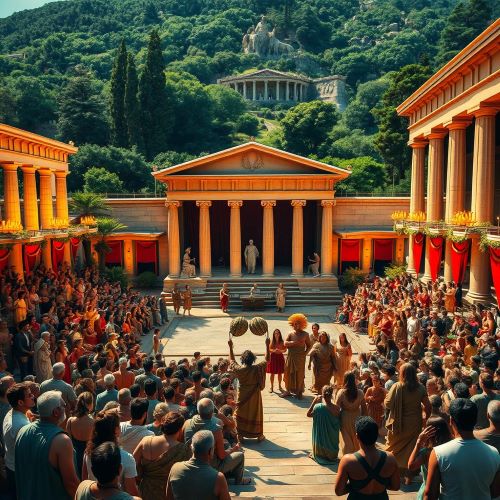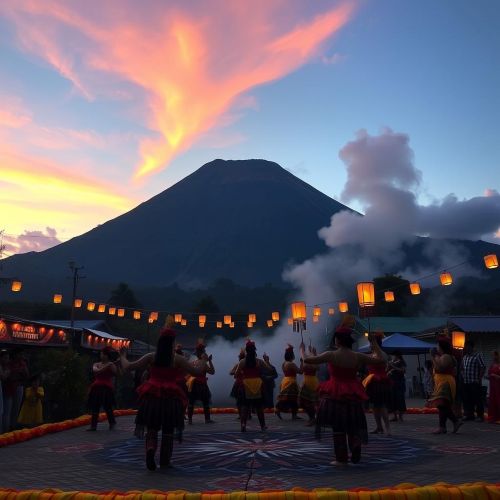Saturnalia : Festival of Revelry
At a glance
| Description | |
|---|---|
| Location | Rome |
| Country | Italy |
| Dedicated To | Saturn |
| Duration | 7 days |
| Time of Year | December |
Introduction
In ancient Rome, few festivals captured the public’s imagination quite like Saturnalia. Celebrated each December, this jubilant holiday honored Saturn, the Roman god of agriculture and time, and unfolded with a spirit of unrestrained joy and merriment. Over time, the celebration expanded from a single day to an entire week, creating a unique pause in Roman life where revelry overtook routine, and society turned itself upside down. With its emphasis on generosity, social levelling, and communal cheer, Saturnalia became more than a religious event—it was the heart of wintertime celebration and the forerunner of many customs that are still cherished today.
Connection with Mythology
Saturnalia wasn’t just about feasting and games—it had deep roots in Roman mythology. The festival paid homage to Saturn, a powerful figure tied to a bygone era known as the Golden Age. According to legend, this was a time when humanity lived in perfect harmony—free from toil, conflict, and inequality. Saturn’s rule represented a world of balance and abundance, which the Romans nostalgically yearned to revive, even if just for a few days each year.
During Saturnalia, this mythological Golden Age was symbolically reenacted. Social boundaries were dissolved, and a festive chaos replaced everyday order. Even the statue of Saturn in the Temple of Saturn was unbound—its feet, usually tied with wool, were freed in a ceremonial act of release, reflecting the temporary liberation from the constraints of daily life. The festival’s timing, close to the winter solstice, underscored themes of renewal, light, and cyclical rebirth, mirroring the sun’s slow return after the darkest days of the year.
Main Activities
The energy of Saturnalia burst into life through a wide range of vibrant traditions. The holiday began with religious rituals, including sacrifices at the Temple of Saturn. This was followed by a grand public feast in the Roman Forum, where citizens of all classes shared in the abundance of the season.
Perhaps the most striking aspect of Saturnalia was the reversal of social roles. Slaves were temporarily freed from their duties, allowed to speak openly, and even dined alongside—or in place of—their masters. These inversions weren’t just tolerated; they were encouraged. Masters would serve meals, and everyone wore the pilleus, a soft cap usually reserved for freed slaves, as a nod to the festival’s emphasis on equality.
Households buzzed with laughter, music, and games. Gift-giving was a central tradition, with presents ranging from simple candles and figurines to playful novelty items. These tokens symbolized warmth, light, and goodwill. Gambling, usually frowned upon, became a popular pastime, enjoyed by people across all levels of society.
Dressing in bright, relaxed clothing added to the mood. Instead of formal Roman togas, revelers wore colorful, informal outfits that reflected the unstructured spirit of the celebration. In some settings, a mock ruler—the “King of Saturnalia”—was chosen, often by chance. This figure, typically a jester-like character, issued humorous commands that guests were obliged to follow, adding a layer of comedic chaos to the festivities.
Importance in Cultural History
At a glance, Saturnalia might seem like little more than a spirited break from routine, but it held deeper meaning for Roman society. In a world that was highly stratified and rule-bound, the holiday provided a controlled outlet for social pressure. By inverting roles and allowing moments of uninhibited freedom, the festival acted as a societal safety valve, reinforcing the structure by temporarily releasing its tension.
The enduring popularity of Saturnalia, which persisted from the Roman Republic into the height of the Empire, reflected its cultural weight. It wasn’t just about indulgence; it was a moment to reconnect with ideals of fairness, joy, and community. Even as the Roman Empire shifted religiously with the rise of Christianity, Saturnalia’s influence endured. Many customs from the festival were adapted into Christian traditions—especially during the celebration of Christmas.
The themes of Saturnalia—light overcoming darkness, generosity replacing duty, and laughter dispelling formality—continue to echo in the festive rituals of winter holidays around the world.
International Appeal
Though Saturnalia was born in Rome, its influence extended far beyond the city’s ancient borders. As the Roman Empire expanded, so did its culture and festivals. Soldiers, merchants, and settlers carried Saturnalia with them across Europe and the Mediterranean. In regions where Roman and local traditions merged, the spirit of Saturnalia became embedded in regional customs.
In Greece, for instance, the Kronia festival shared similar attributes, honoring the god Kronos (the Greek equivalent of Saturn) with role reversals and celebratory feasts. As centuries passed, echoes of Saturnalia could be found in medieval European festivities like the Feast of Fools, where norms were similarly turned upside down, and jesters ruled the day.
Even during the Renaissance and Victorian eras, traces of Saturnalia resurfaced in holiday traditions. The appointment of a mock “Lord of Misrule” during Christmas celebrations, the use of candles and evergreen decorations, and the practice of seasonal gift-giving all harken back to this ancient Roman festival.
Today, Saturnalia’s legacy lives on in ways we might not immediately recognize. The festive warmth of winter holidays, the spirit of generosity and togetherness, and the cultural embrace of joy in the face of darkness are all rooted, in part, in this age-old celebration.
Source
Cartwright, M. (2016). Saturnalia: The Jolliest of Roman Festivals. World History Encyclopedia. Retrieved from https://www.worldhistory.org/Saturnalia/.
Encyclopaedia Britannica. (2025). Saturnalia Celebration, Sacrifice, & Influence on Christmas. Retrieved from https://www.britannica.com/topic/Saturnalia-Roman-festival.
Wikipedia contributors. (2025). Saturnalia. Retrieved from https://en.wikipedia.org/wiki/Saturnalia.
Beard, M., North, J., & Price, S. (1998a). Religions of Rome: Volume 1, A History. Cambridge University Press.
Beard, M., North, J., & Price, S. (1998b). Religions of Rome: Volume 2, A Sourcebook. Cambridge University Press.
Dolansky, F. (2011). Celebrating the Saturnalia: Religious ritual and Roman domestic life. In B. Rawson (Ed.), A Companion to Families in the Greek and Roman Worlds (pp. 484–494). Wiley-Blackwell.
English Heritage. (2020, February 19). Saturnalia. https://www.english-heritage.org.uk/learn/story-of-england/saturnalia/
History.com Editors. (2017, December 5). Saturnalia: Meaning, Festival & Christmas. HISTORY. https://www.history.com/topics/ancient-rome/saturnalia
Frequently Asked Questions
Lorem ipsum dolor sit amet, consectetur adipiscing?
Lorem ipsum dolor sit amet, consectetur adipiscing elit. Praesent convallis vestibulum justo, ac tincidunt nunc vehicula quis. Nullam id dolor quis orci malesuada feugiat. Curabitur aliquet libero at urna ullamcorper, ac ultricies nulla dapibus.
Lorem ipsum dolor sit amet, consectetur adipiscing?
Lorem ipsum dolor sit amet, consectetur adipiscing elit. Praesent convallis vestibulum justo, ac tincidunt nunc vehicula quis. Nullam id dolor quis orci malesuada feugiat. Curabitur aliquet libero at urna ullamcorper, ac ultricies nulla dapibus.
Lorem ipsum dolor sit amet, consectetur adipiscing?
Lorem ipsum dolor sit amet, consectetur adipiscing elit. Praesent convallis vestibulum justo, ac tincidunt nunc vehicula quis. Nullam id dolor quis orci malesuada feugiat. Curabitur aliquet libero at urna ullamcorper, ac ultricies nulla dapibus.
Lorem ipsum dolor sit amet, consectetur adipiscing?
Lorem ipsum dolor sit amet, consectetur adipiscing elit. Praesent convallis vestibulum justo, ac tincidunt nunc vehicula quis. Nullam id dolor quis orci malesuada feugiat. Curabitur aliquet libero at urna ullamcorper, ac ultricies nulla dapibus.
Lorem ipsum dolor sit amet, consectetur adipiscing?
Lorem ipsum dolor sit amet, consectetur adipiscing elit. Praesent convallis vestibulum justo, ac tincidunt nunc vehicula quis. Nullam id dolor quis orci malesuada feugiat. Curabitur aliquet libero at urna ullamcorper, ac ultricies nulla dapibus.








